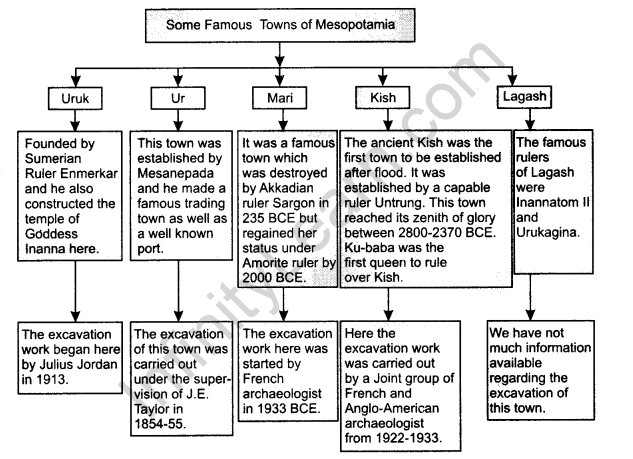- A great civilization flourished in Mesopotamia around 5000 BCE.
- Mesopotamia is the modern Iraq.
- Originally Mesopotamia is a Greek word which means the land between two rivers.
- Tigris and Euphrates were the two rivers between which the civilization of Mesopotamia flourished.
- Mesopotamia is a flat plain. The excavation work started here about 150 years ago.
- Sumer region was the lower part of the Mesopotamian civilization.
- It was the heart of the civilization.
- Sumerians were the first to develop a civilization in Mesopotamia. That is why the civilization has been named after them, i.e. Sumerian civilisation.
- As per excavations , there were three types of cities in Mesopotamia. They were religious, commercial and royal cities.
- Ur, Lagash,Kish, Uruk and Mari were some of the most important cities of Mesopotamian civilisation.
- Soil of Mesopotamia was very fertile but agriculture was threatened because of natural causes. The crops grown were wheat, barley, peas and lintel.
- Mesopotamian civilization was based on a definite plan.
- There were three kinds of slaves that existed in Mesopotamian society. They were war prisoners, children sold by their parents and those who failed to pay their debt. They were ill treated.
- Mesopotamian society consisted of three classes, i.e. Upper class, Middle class and Lower class.
- Ruling class, the nobles, the royal people and the high officials belonged to the upper class.
- Members of the upper class led a luxurious life.
- Merchants, traders, landlords, artisans, craftsmen belonged to the second class.
- Slaves belonged to the lower class.
- Cows, goats, oxen and sheep were the main animals of domestication.
- Hammurabi, the great, was the ruler of Mesopotamia during the period of 2067-2025 BCE.
- Code of conduct was the greatest contribution of Hammurabi. They were 282 in numbers and covered every aspect of life.
- Cuneiform script was the script of Mesopotamia.
- Mesopotamians had great interest in literature also. Gilgamesh was their famous epic. It was the work of Uruk who was the ruler of Mesopotamia in 2700 BCE.
- Mesopotamians were interested in mathematics too.
- Sixty important numbers have been found in their numerals.
- Babylonia had an important role in the history of Mesopotamia.
- Temples of Mesopotamia also had much importance in the history of Mesopotamia. Temples were centres of religious activities. These temples were dedicated to different gods and goddesses.
Important terms:
- Mesopotamia: The land between two rivers. It is made of Greek words ‘Mesos’ meaning middle and ‘Potamos’ meaning river.
- Division of labour: In this system, each labour/person is given a particular part of work in which he is skilled.
- Nuclear Family: A very small family consisting of husband, wife and their children.
- Cuneiform: The wedge-shaped symbol which represents the syllables and sound of a word.
- Steles: Stone slabs with inscriptions or carvings.
| TIMELINE | |
| Years | Event |
| C. 7000 – 6000 BCE | Beginning of agriculture in the northern Mesopotamian plains |
| C. 5000 BCE | Earliest temples in southern Mesopotamia built |
| C. 3200 BCE | First writing in Mesopotamia |
| C. 3000 BCE | Uruk develops into a huge city, increasing use of bronze tools |
| C. 2700 – 2500 BCE | Early kings, including, possibly, the legendary ruler Gilgamesh |
| C. 2600 BCE | Development of the cuneiform script |
| C. 2400 BCE | Replacement of Sumerian by Akkadian |
| 2370 BCE | Sargon, king of Akkad |
| C. 2000 BCE | Spread of cuneiform writing to Syria, Turkey and Egypt; Mari and Babylon emerge as important urban centres |
| C. 1800 BCE | Mathematical texts composed; Sumerian no longer spoken |
| C. 1100 BCE | Establishment of the Assyrian kingdom |
| C. 1000 BCE | Use of iron |
| 720-610 BCE | Assyrian empire |
| 668-627 BCE | Rule of Ashurbanipal |
| 331 BCE | Alexander conquers Babylon |
| C. 1st century CE | Akkadian and cuneiform remain in use |
| 1850’s | Decipherment of the cuneiform script |
Flow-Learning:







